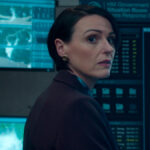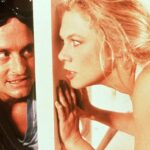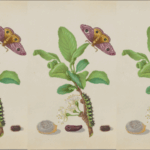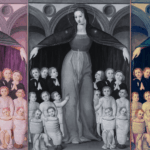Judy Melinek, M.D. and T.J. Mitchell are the New York Times bestselling co-authors of the memoir Working Stiff: Two Years, 262 Bodies, and the Making of a Medical Examiner (Scribner, 2014). Dr. Melinek was a medical examiner in San Francisco for nine years, and today works as a forensic pathologist and medico-legal consultant. T.J. Mitchell, her husband, is a writer with an English degree from Harvard, and worked in the film industry before becoming a stay-at-home dad and novelist. First Cut (Hanover Square, January 2020) is their debut novel, launching a forensic-noir detective series.
Coauthors, Till Death Do Us Part
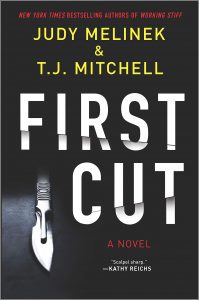 Judy: It was a crime scene on Post and Larkin in San Francisco, early in my career as a medical examiner, that gave me the idea for our novel. I was on call, and got sent to a late-night death scene in a coffee shop next to a gelateria. The café’s windows were full of bullet holes, beveled in a way that told me the shooting had taken place inside. There was a dead man crumpled in front of the gelateria’s counter. Witnesses told the homicide detectives that our decedent had jacked a laptop computer off a man seated at a table in the café. That guy then jumped up, pulled a gun, and started shooting. He chased the thief out to the gelateria and gunned him down, shooting him in the forehead before taking the computer out of his dead hands and walking away.
Judy: It was a crime scene on Post and Larkin in San Francisco, early in my career as a medical examiner, that gave me the idea for our novel. I was on call, and got sent to a late-night death scene in a coffee shop next to a gelateria. The café’s windows were full of bullet holes, beveled in a way that told me the shooting had taken place inside. There was a dead man crumpled in front of the gelateria’s counter. Witnesses told the homicide detectives that our decedent had jacked a laptop computer off a man seated at a table in the café. That guy then jumped up, pulled a gun, and started shooting. He chased the thief out to the gelateria and gunned him down, shooting him in the forehead before taking the computer out of his dead hands and walking away.
I gloved-up to examine the body and surrounding evidence, and answered the usual professional questions I get from detectives, about the wound trajectories and probably shot sequence—but the whole time we were working that scene I harbored an unasked question of my own.
“What is on that laptop that was worth killing over?”
It turned out to be the prompt for a novel. I started writing, at first during my lunch hour out of the morgue, and then whenever I could find the time. Eventually I handed the story to my husband, the wordsmith in our partnership. We work well together because we have no overlapping skill set: I know the forensics and I can come up with a good story, and T.J. performs the writing mechanics, working and reworking an idea into a narrative.
A Marriage of Fact and Fiction
T.J.: Judy and I had already collaborated, successfully and with a lot of joy, on our first book, Working Stiff, but that was entirely different. Working Stiff is nonfiction, a memoir. At first, her handing me a chunk of fiction seemed a dream come true. There were many times, while we were writing Working Stiff, that I felt tied down by the material. I had to stick to the facts and craft them into a story, but I couldn’t make stuff up—even if I badly wanted to make stuff up. Now my writing partner is handing me a hundred or so pages of a murder mystery based on what she really does in her fascinating workplace. She’s given me a badass heroine, the crime that sets everything in motion, many of the essential plot elements, most of the supporting characters, and, best of all, the ending! How hard could it be to turn that into a detective novel, right?
Right…?
When I started this process, I also faced a personal complication that turned out to be an advantage: I was not especially well-read in detective fiction. Because I knew little about the genre, I had no specific authors I wanted to emulate. I spent the next several months reading one book after another to learn the structure and rhythm, the reader’s expectations and the sleight-of-hand narrative elements that made me, very quickly, a convert to the style and substance of the noir detective novel. Judy and I then set out to apply the scientific and investigative methods and materials she uses in real life to this realm of fiction. That’s how we found our voice, our niche.
Microscopes and Metaphysics
Judy: Our most productive work together seems to happen by going on walks in our neighborhood, out to Sutro Heights or Ocean Beach. T.J. prompts a discussion by telling me where he’s left off writing, and reminding me where we need to get to next, and then asking, “so what happens in between?” I might start rattling off the forensic investigative method I would use in the fictional situation we’re exploring, and then he will adapt that protocol into something we hope is a compelling narrative that maintains real-world accuracy. It can be tricky. A working forensic pathologist like me does get to play detective, but it’s not like you see on TV. I don’t run around with a gun. I don’t interrogate evildoers. I do use science to answer questions about sudden, unexpected, and violent deaths, and sometimes I even solve mysteries—but real forensic science takes weeks or months, and most of my work is done on the phone or at the microscope.
T.J.: Yeah, that’s a problem. I’ve found that I keep asking Judy, isn’t there something we can do to get Dr. Teska (our heroine) out from behind her desk? Can’t we find a way to cheat the toxicology results so they only take, like, a couple of weeks instead of a couple of months…? It’s tricky, balancing the demands of verisimilitude and narrative momentum. I give Dr. Melinek assignments, asking her to check with her friends in the district attorney’s office to make sure we get the criminal law right, or tracking down that medical school friend who went into DNA research, to gut-check our hard science. Mostly what I want to know is how these real-life experts might help our imagined forensic pathologist pull questions out of other made-up people that will advance the plot of the story that they don’t even know they’re in!
Judy: Yes, while T.J. plays with our imaginary friends, I go out and ask real people to help them get where they need to go. Outside of the autopsy suite, I spend most of my day interacting with cops and attorneys. I can tune-in to the way they talk; I get to read interrogation reports and deposition transcripts to learn what they’re talking about, and even pick up their cadences. And if T.J. gets stuck on a plot point, I can suggest a new direction based on some of my actual cases.
Write What You Know
T.J.: I’ve gone into court to watch Dr. Melinek testify in murder cases, so I could get a good sense of the room and the way everyone interacts in it, and what information I can and cannot evoke in a cross-examination. She even once got permission for me to observe an autopsy with some medical students. That’s an experience I don’t plan to repeat. Some things are better left to the experts.
Judy: I feel the same way about sitting alone in a room, wrangling adjectives!
T.J.: There you have it. Coauthors, till death do us part.




